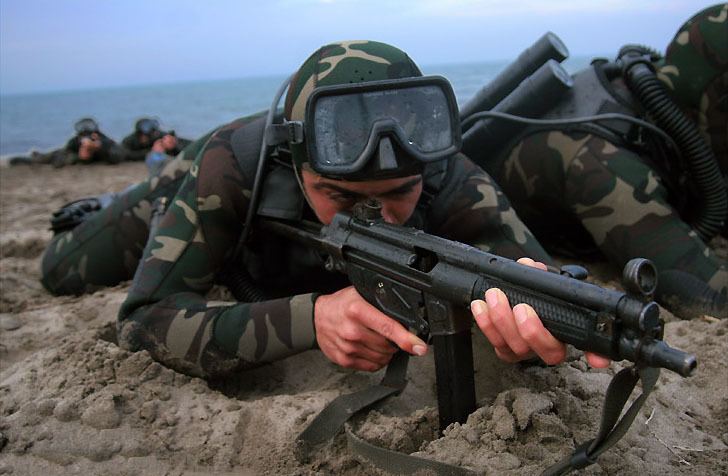 | ||
The Navy of the Army of the Guardians of the Islamic Revolution or Revolutionary Guards' Navy (Persian: نیروی دریایی سپاه پاسداران انقلاب اسلامی), acronymed NEDSA (Persian: ندسا), consists of 20,000 men and 1,500 boats and fast attack boats separate from the regular Navy of Artesh assuming control over Iranian maritime operations in the Persian Gulf. IRGC’s Navy has steadily improved its capabilities to support unconventional warfare and defend Iran’s offshore facilities, coastlines, and islands in the Persian Gulf.
Contents
Overview
IRGC Navy and Artesh Navy overlap functions and areas of responsibility, but they are distinct in terms of how they are trained and equipped— and more importantly also in how they fight. The Revolutionary Guards Navy has a large inventory of small fast attack craft, and specializes in asymmetric hit-and-run tactics. It is more akin to a guerrilla force at sea, and maintains large arsenals of coastal defense and anti-ship cruise missiles and mines.
It has also a Takavar (special force) unit, called Sepah Navy Special Force (S.N.S.F.).
Watercraft: Total 50+
Aircraft
Coastal Anti-Ship Missiles
Facilities
It is believed that the IRGC's Navy has facilities on the following islands:
Iran-Iraq war
During the "Tanker War" phase of the Iran-Iraq war, beside the regular Iranian Navy, IRGC started employing swarm tactics and surprise attacks using Boghammar speedboats fitted with rocket launchers, RPGs, and heavy machine guns. Attacks on Kuwaiti tankers, an Iraqi ally, eventually dragged US Navy into the Persian Gulf to escort Kuwaiti tankers. As a response, IRGC ordered mining west of Farsi Island on the route of the very first caravan—the Kuwaiti supertanker SS Bridgeton escorted by four US warships—which successfully hit the tanker itself.
British Royal Navy
On 21 June 2004, eight sailors and Royal Marines were seized by forces of the Revolutionary Guards' Navy while training Iraqi river patrol personnel in the Persian Gulf. On 23 March 2007, fifteen sailors and Royal Marines from HMS Cornwall were seized by forces of the Revolutionary Guards' Navy in the Persian Gulf.
United States Navy
On 7 January 2008, US officials claimed five Iranian speedboats 'harassed' United States Navy vessels in the Persian Gulf. IRGC speedboats made threatening moves and in one case even came within 180 meters of US warships. The US Navy also claimed to have received a radio transmission from Iranian boats saying: "I am coming at you. You will explode in a couple of minutes". After this US ships were said to have taken up their gun positions and were ready to open fire at one of the boats when the Iranians turned away and one of the Iranian speedboats (allegedly) dropped white boxes into the water in front of the U.S. ships, it was not clear what was in the boxes. Iranian officials and military commanders later downplayed the incidents as normal and denied having sent the radio transmission. After the US released a video showing Iranian speedboats swarming US ships in the Strait of Hormuz, Iran released its own video of the incident after suggesting the US video was staged.
On 12 January 2016,10 American sailors were apprehended by IRGC officials off the coast of Farsi Island, which doubles as a naval installation for the IRGC. American officials stated that the sailors were on a training mission when one of their boats experienced a mechanical failure. During this time the vessel drifted into Iranian territorial waters spurring IRGC naval units to respond and apprehend the sailors with both vessels. US Secretary of State John Kerry engaged in a phone call with Iranian officials to defuse the situation. Iranian officials said that the sailors were in custody, but would be freed within hours, understanding that the incident was a mistake.
